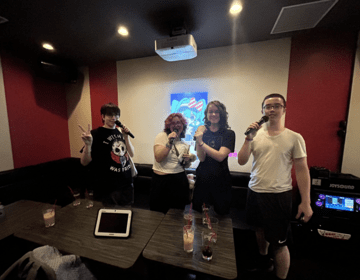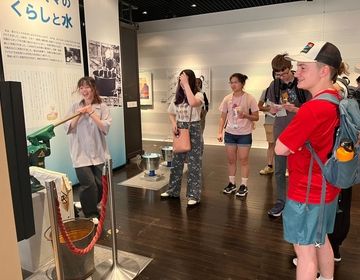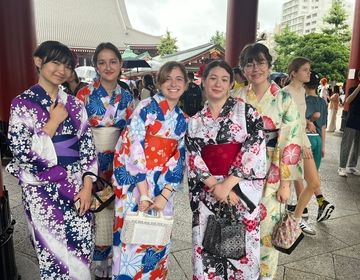An Exciting Weekend: Tsumami-Zaiku, Asakusa, and More!
Things have been going by so quickly on this program and we can’t believe it’s almost over. Before things come to an end though, here is a quick recap of our adventures from the past weekend!
Friday was mostly a cozy and relaxing day spent at the hostel. All of our navigators’ classes, as well as the cultural activity, took place inside the hostel. In the morning, students had a chance to keep working on their final project (which they will be presenting this week!), and in the afternoon they took their final Japanese class with Ms. Atsuko. We hope that the language skills they gained in these classes help them continue to deepen their understanding of Japanese pop culture.
After class, students had the opportunity to take part in a Tsumami-zaiku workshop! “Tsumami” (つまみ) means “pinch,” and refers to the Japanese traditional craftwork that is typically used to make Kanzashi, the hair ornaments worn by Maiko (geishas in training). Tsumami works by pinching and folding cloth with tweezers like one would do with origami paper. This was another wonderful opportunity for our navigators to gain a better understanding of parts of Japanese culture which they might have only seen through a screen before. They also got a nice souvenir out of the experience, one made by themselves!
Saturday was sort of the opposite of our previous day inside. We left the hostel early in the morning and headed to Tokyo Solamachi, a large shopping and entertainment complex at the bottom of Tokyo Skytree, Japan’s tallest tower. Here students had the chance to play against each other in the HADO Arena. HADO can be described as an eSport which uses Augmented Reality technology to combine the physical world with the virtual one. With this activity, our navigators were able to experience some of the unique approaches Japan has been taking towards gaming outside of consoles and computers. After competing against their peers, and defeating the program leaders quite easily, students had the chance to eat and shop around Tokyo Solamachi before we headed to our next destination.
A trip to Tokyo would definitely not be complete without visiting Asakusa, a district in Japan known for its historical monuments and “older vibe.” Here one can see many Japanese people and foreigners wearing traditional garments such as the Yukata and Kimono to match the historical atmosphere. Asakusa’s main attraction is easily Sensōji Temple, a Buddhist temple recognizable to all due to its magnitude and giant red lanterns. When visiting the temple, one first walks through the outer gate, Kaminarimon, which is followed by a second gate called Hōzōmon. Beyond these two massive structures lies a shopping street leading to Sensōji, where many navigators decided to get their fortune (Omikuji)! In the case of a bad fortune, there is no need to panic. You can always tie up your slip in the designated temple area to make sure it does not come true.
The last day of the weekend was a free day for our students. They were all able to plan out their own schedule and visit the places they most wanted to in Tokyo. Some decided to use this day to rest a bit, which was a wonderful choice after two weeks of non-stop classes and activities. Others spent the whole day outside of the hostel exploring the city. For example, many of our navigators took this as an opportunity to visit Tokyo Disneyland or Tokyo DisneySea! Here is what one of them had to say about this experience:
“I had a lot of fun, and I rode Indiana Jones, Raging Spirits, Tower of Terror, and Journey to the Center of the Earth” – Hero
It seems our navigators were keeping busy the entire day! These three days were a wonderful way to wrap up the program’s second week in Japan, giving our students the chance to both relax a bit and also do a lot more exploration. But things are not over yet and there is still a lot left to do, so make sure to check out the other blogs coming out this week!
Related Posts

First Week in Tokyo: A High Schooler's Reflection
Evelyn C. ventured to Tokyo as a part of CIEE's High School Summer Abroad Anime & Manga Program. Staying in a youth hostel in Iidabashi, a bustling yet scenic area... keep reading

Tokyo Adventures and Beyond
Our students are already settling into Tokyo life! These past two weeks have been a whirlwind of exploration and learning. From navigating the train system like pros to savoring delicious... keep reading

Tokyo Time Travelers!
Our Tokyo Global Navigators have gotten this week off to a strong start exploring Tokyo's culture and history! On Saturday they journeyed into the future of science and technology with... keep reading
